Change can be good, even when it’s incremental. When Moto Guzzi upped the ante with the 850 Eldorado, replacing the 750 Ambassador, it was all good.
The new model had a slightly larger engine, another gear in the transmission, neither anything to complain about. This was a big, comfortable motorcycle that handled surprisingly well, if a bit slowly. Any go-fast Guzzista wanting really refined handling would buy the race-worthy companion, the V7 Sport.
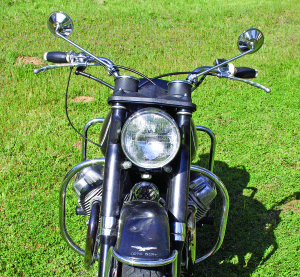
Slide a leg across the saddle, turn on the two petcocks which feed the two Dell’Orto 29mm square-slide carburetors, do a little tickling, turn the key up by the headlight, use the choke if cold, push the starter button, sparks fly through an automotive-type distributor, and a very nice rumble comes out of the two mufflers. Pull in the clutch, toe the shift lever up (or heel it down) to first gear, gently release the clutch, and the rider is away, smoothly. Shift at 5,000 rpm, and by the time one gets to fifth the speedometer is reading 100 mph.
A little history here. Moto Guzzi began building motorcycles after World War I and was justifiably famous for its 500cc single-cylinder machines, the cylinder laying flat, pointing forward. After World War II the factory, which had escaped Allied bombing, continued as before, but these models were getting a bit long in the tooth. In the 1950s, a number of two-stroke and four-stroke models, all under 250cc, were produced, catering to the demand for inexpensive personal transportation.
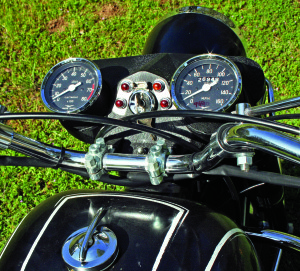
Along about 1959, the Italian government asked the company to produce a utilitarian three-wheeler for military use, which it did, powering it with a low-revving, under-stressed 754cc 90-degree V-twin that had loads of torque but only 20 horses at 4,000 rpm. After that contract ended, the factory wondered what could be done with this efficient, low-maintenance engine. Then the government announced that it was looking for a reliable motorcycle for the military and police, from any Italian company; one proviso was that the engine be good for at least 100,000 kilometers (62,000 miles) without needing major repairs.
Guzzi engineers rapidly came up with the idea of putting the V-twin between two wheels and giving it some horsepower. The engine was reduced to 703cc, with a bore of 80mm, stroke, 70mm, and at 6,000 rpm generated some 50 horses. The government loved it, and gave out contracts. Soon, civilians were demanding a chance to own this machine. The V7 appeared at the Milan show in December 1965, and soon got a reputation for being bulletproof.
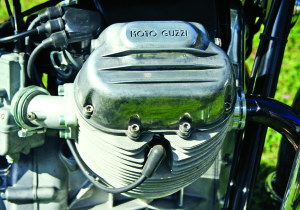
The engine was carried low in the tubular, double-cradle frame, with fattish 18 x 4.00 tires providing good grip in the curves. The camshaft was up in the crotch of the Vee, minimizing the length of the pushrods. Six pints of oil went into the wet sump, with an excellent lubrication system sending it wherever necessary. At the front of the engine a belt was used to drive a big 300-watt Marelli generator that sat between the cylinders. Under the saddle was a 32-amp/hour battery, and on the left side was a Marelli 0.7-horsepower starter motor; this may have been the first motorcycle to come with just an electric starter, no kickstarter back-up like Harley and all the Japanese had. The big battery was there to boost the rider’s confidence.
A four-plate—two friction, two plain—clutch carried the power from the longitudinal crankshaft to the 4-speed gearbox, and then via shaft to the rear wheel. One entertaining note: the earliest V7s had straight-cut gears, which were exceptionally noisy, but by March of ’68 helical gears were being used…to everybody’s satisfaction.
For 1969, the engine was bored out to 757cc, and a model for the American market—with newly required sealed-beam headlight—was called the Ambassador. New cylinder heads were used, with a higher compression ratio, which helped up the horsepower to 60. In June of 1969, a much modified Ambassador went 145 mph on the Monza racetrack.
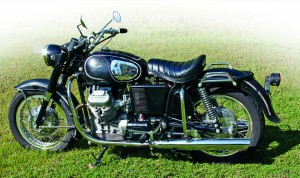
Two years later the engine was stroked to 844cc, compression increased to 9.2:1, and the Eldorado was created. This model actually had two names, one being the 850GT (Gran Turismo) in Europe, and the Eldorado for the American market. Moto Guzzi’s American importer, Mike Berliner’s Premier Motor Corporation, was going to give Harley-Davidson a bit of competition for the lucrative police contracts. Also, the Eldorado had a lot of touring potential, especially with that maintenance-free shaft drive. A full-dress version, called the California, became available, with a windscreen, saddlebags and a host of other touring amenities, rather like Harley’s Electra Glide. The American aftermarket had already picked up on the Ambassador model, offering handlebar fairings, travel trunks…all the regalia touring riders loved.
For a minor comparison, the Harley FLH weighed in at close to 800 pounds, while the Guzzi Eldorado was under 600 pounds. Both engines were OHV V-twins and both claimed about 65 horsepower, but the Harley was 1,200cc, the Guzzi, 850. The FLH’s wheelbase was over 61 inches, while the Eldo was a far sportier 58 inches—very useful when doing U-turns, which police officers were often called upon to do. And there was the matter of price—with the Harley going for $2,500, the Guzzi for $2,000. In the early 1970s, the Los Angeles Police Department bought a slew of Guzzis, as did the California Highway Patrol and other constabulary forces across the country. Berliner did achieve his goal in a minor way, though he did not come close to unseating Harley’s police presence.
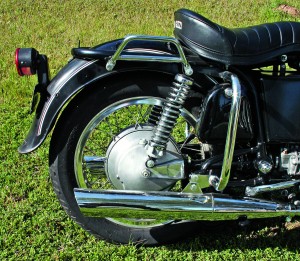
The Eldo was aimed at the rider who wanted to cover long distances without pain. A long single seat was available for solo riders, while a plush dual seat was available for two-up touring. Wide fenders kept the rain and road grime at bay. The brakes were of the drum variety, using a twin-leading shoe on the front and single-leading shoe on the rear; both drums were identical at 8.7 inches in diameter, 1.7 inches wide. Several overly enthusiastic test riders complained about brake fade after a couple of hard stops, and options became available. One was the four-leading shoe front brake from the V7 Sport, another being a Brembo single disc.
However, new management at Guzzi decided to play up the sporty side of things, and dropped the touring Eldorado in favor of the 850T late in 1974, the T using the V7 Sport frame and abbreviated fenders. And the police market went away.
(This Retrospective article was published in the October 2012 issue of Rider magazine.)







The engine of the 3-wheeler “Mechanical Mule” is similar in basic layout, but totally different than the unit used in the V700 and subsequent motorcycle models. Here’s a section from “Moto Guzzi Big Twins” by Greg Field:
“Individually, Carcano and Todero had each worked on 90-degree Vs in the past. Carcano had designed an air-cooled 600 cc engine designed to power the Fiat 500 car, and Todero had helped develop the fan-cooled 750 cc engine for the 3×3 Mechanical Mule, an engine designed by another Moto Guzzi engineer, Antonio Micucci.
Neither the Fiat 500 nore the Mule engine was used as the basis for the V700 engine, however, and it’s somewhat puzzling how the whole misconception got started, given the fact that the Mule engine was designed by Micucci, rather than Carcano. The fact is, all the V700 engine and the other two share in common is a 90-degree V-angle. “Comparing the head design and structure, the distribution, displacement, lube and fuel systems and engine crankcases is enough to demonstrate that the engines are totally different and come from different ideas, ” asserted Todero. Said Carcano on the issue: “The (Mule) engine has nothing in common with the V7. It had a forced cooling system and was a 90-degree V, but it’s cylinders, heads, and engine casing, etc., differed completely.”
Eldo”s are incredible comfort to ride center of gravity fantastic heavy enough to stick well alongside tractor trailers on hwy or in heavy rain ez maintainence ((everthing is outside where can access)) adjust carbs underway or @ stoplight made a mistake when dropped model california is close but eldo is a blend of a stone & california built together only way I’d give up my eldo is for a convert now @ age 68 vintage guzzi”s are a trusted friend with personality gentleman in the city or holding onto the ears of a upset bear if need -_-